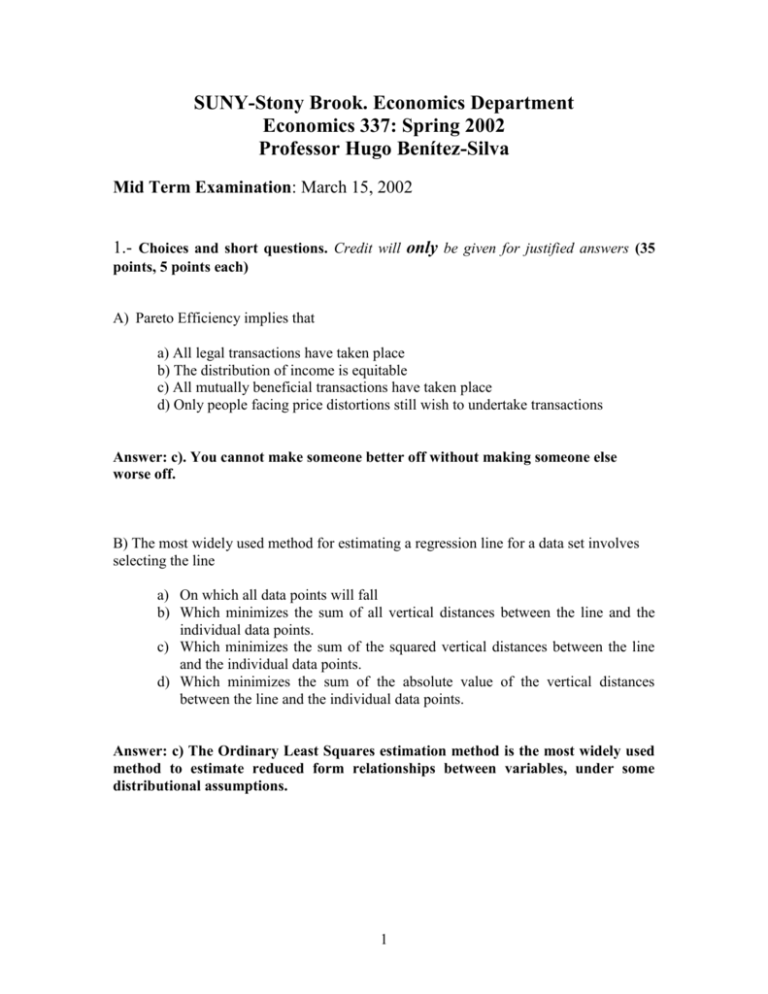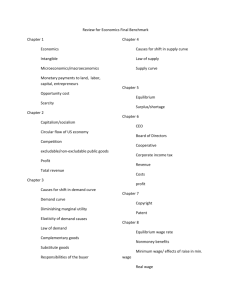Solutions to Midterm Exam
advertisement

SUNY-Stony Brook. Economics Department Economics 337: Spring 2002 Professor Hugo Benítez-Silva Mid Term Examination: March 15, 2002 1.- Choices and short questions. Credit will only be given for justified answers (35 points, 5 points each) A) Pareto Efficiency implies that a) All legal transactions have taken place b) The distribution of income is equitable c) All mutually beneficial transactions have taken place d) Only people facing price distortions still wish to undertake transactions Answer: c). You cannot make someone better off without making someone else worse off. B) The most widely used method for estimating a regression line for a data set involves selecting the line a) On which all data points will fall b) Which minimizes the sum of all vertical distances between the line and the individual data points. c) Which minimizes the sum of the squared vertical distances between the line and the individual data points. d) Which minimizes the sum of the absolute value of the vertical distances between the line and the individual data points. Answer: c) The Ordinary Least Squares estimation method is the most widely used method to estimate reduced form relationships between variables, under some distributional assumptions. 1 C) Given the following data, what is the labor force participation rate. Population: 200 million; employed: 120 million; unemployed: 11 million; retired: 20 million; under the age of 16: 30 million Write your answer below showing your calculations. Numerator: 120+11 Denominator: 120+11+20 (or 200-30) D) For two substitutes in production, if the scale effect dominates a) b) c) d) e) Then the inputs are gross complements Then the inputs are gross substitutes Then the inputs could be either gross complements or gross substitutes Then the inputs cannot be used at the same time None of the above Answer: a) The scale effect moves employment in the same direction as for the own input. That means the inputs are complements. E) If the quantity of auto workers demanded decreases from 66,000 to 54,000 when the equilibrium wage increases from $12 to $14 per hour, then the own-wage elasticity of demand for these workers is: a) b) c) d) e) Inelastic Elastic Zero Neither elastic nor inelastic Not enough information is provided Answer: b) –1.090909 Numerator: (66,000-54,000)/66,000 Denominator: (12-14)/12 2 F) Give at least two reasons why increasing the overtime pay premium to double time may not result in overtime hours being converted to additional employment. Answer: Pages 152 and 153 in the book. 1. Average cost of labor increases, forced to use less overtime when they were doing it when maximizing profits. 2. Even if there is a substitution to more capital intensive technologies the cost would tend to increase, leading to a scale effect that would decrease employment. 3. Degree of substitutability between those who work overtime and those unemployed may be low. 4. Some of the adjustments come from reducing straight time hours. G) The presence of minimum wage laws a) Increases the likelihood of observing on-the-job training among unskilled workers. b) Decreases the likelihood of observing on-the-job training among unskilled workers. c) Has little effect on training among either the unskilled or skilled workers. d) Increases the likelihood of observing on-the-job training among the skilled. e) None of the above Answer: b) Given that employers cannot reduce the wage during the training period below the minimum wage, in subsequent periods the quit rates are likely to be very high if the employer wants to recuperate the initial investment. This is likely to lead to lower initial training investment or to the absence of investment. 3 2. Essay Questions. These questions are designed to test your ability to analyze fairly realistic situations with the tools learned in class. Credit will almost exclusively be given for answers that make that connection. Use the space provided below. (15 points each) A) The new Japanese government is concerned with the country’s slow growth of employment. The government is therefore considering a program that would reduce employer payroll taxes (quite high in Japan). Analyze how this reduction of employer payroll taxes would be likely to affect Japanese employment levels. Explain your reasoning. Proposal cuts employer labor costs associated with each level of employee wage. Employers want more labor at each employee wage. Shift up of the labor demand. Employment would increase if labor supply curve is upward sloping, would stay the same if the supply curve were vertical. B) In recent years (and months), many plants have closed, forcing thousands of workers out of their jobs and into new ones. Studies of wage loss suffered by these displaced workers find that, among groups of workers with exactly the same skills and types of training, workers who had been with the firm for many years and were in the 55-64 age range, had greater wage losses than those in the 25-34 age range. Is it possible that the presence of employer-provided specific training (among the new employers of these displaced workers) could cause this outcome? Explain your reasoning. The decreased attractiveness of older workers as objects of human capital investments, due to their shorter expected tenure, would drive down their wage offers relative to those of otherwise comparable younger workers. 4 3. Tax collectors and taxes. Suppose that the supply curve for tax collectors is Ls=20 and the demand curve for tax collectors is Ld=100-20W, where L= the number of tax collectors and W= the hourly wage. a) Graph both the demand and supply curves. (5 points) 100-20W=20, from this W=4 You were expected to graph the curves here, notice that the supply is a vertical line. b) Now suppose that the government imposes a tax of $1 per hours per worker on companies hiring tax collectors. Draw the new (after tax) demand and supply curves in terms of the employee wage. How will this tax affect the wage of tax collectors and the number employed of tax collectors? (5 points) 100-20(W+1)=20, from this W=3 c) If in the long run the supply of tax collectors is an upward sloping function of wages, will the tax have a different effect on the wages of tax collectors, explain? (5 points) If the supply curve were to be upward sloping the effect on wages would be smaller. Wages would not decrease by the amount of the tax, but less. 5 4. Specific Training. Consider a firm that incurs real expenditures for specific training in the current period equal to 150 per worker. During the training period, the workers have a marginal product of 400 and are paid a real wage of 375. Next year, after the training is over, marginal productivity is expected to rise to 535. Answer the following. a) If the firm wanted to recover all its training costs in the initial year after training, what would be the maximum wage it could offer the workers, assuming the interest rate is 6 percent? (10 points) Z+W0 +W1/(1+r) = MP0 +MP1/(1+r) 150 + 375 +W1/(1+0.06)= 400 +535/(1+0.06) W1= 402.5 b) Are workers likely to find this training program attractive? (5 points) We know that MP* has to be at least 400. We also know that W0 +W1/(1+r) >= W* + W*/(1+r) 375+ 402.5/(1+0.06) >= 400 + 400/(1+0.06) 754.72 >= 777.36, NO Not attractive Another alternative is to leave MP* as an unknown and find that the implied MP* to make the training available had to be below 400, which is not possible. c) Is there a productivity level MP1 such that you would find a different answer for b)? (5 points) Yes, there is. We just have to find the W1 that would make the training attractive and then find out the appropriate MP1 from the formula we have already used. How does MP1= 559 or larger sound? 6








